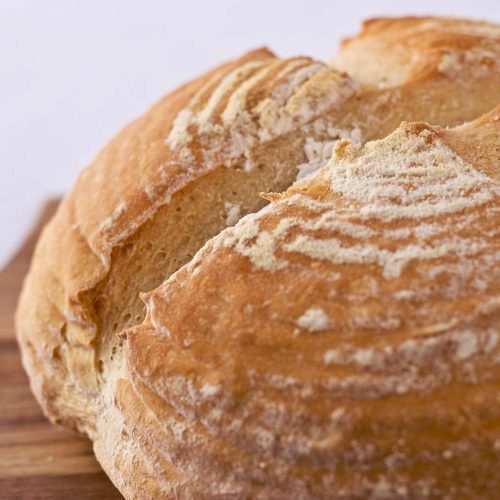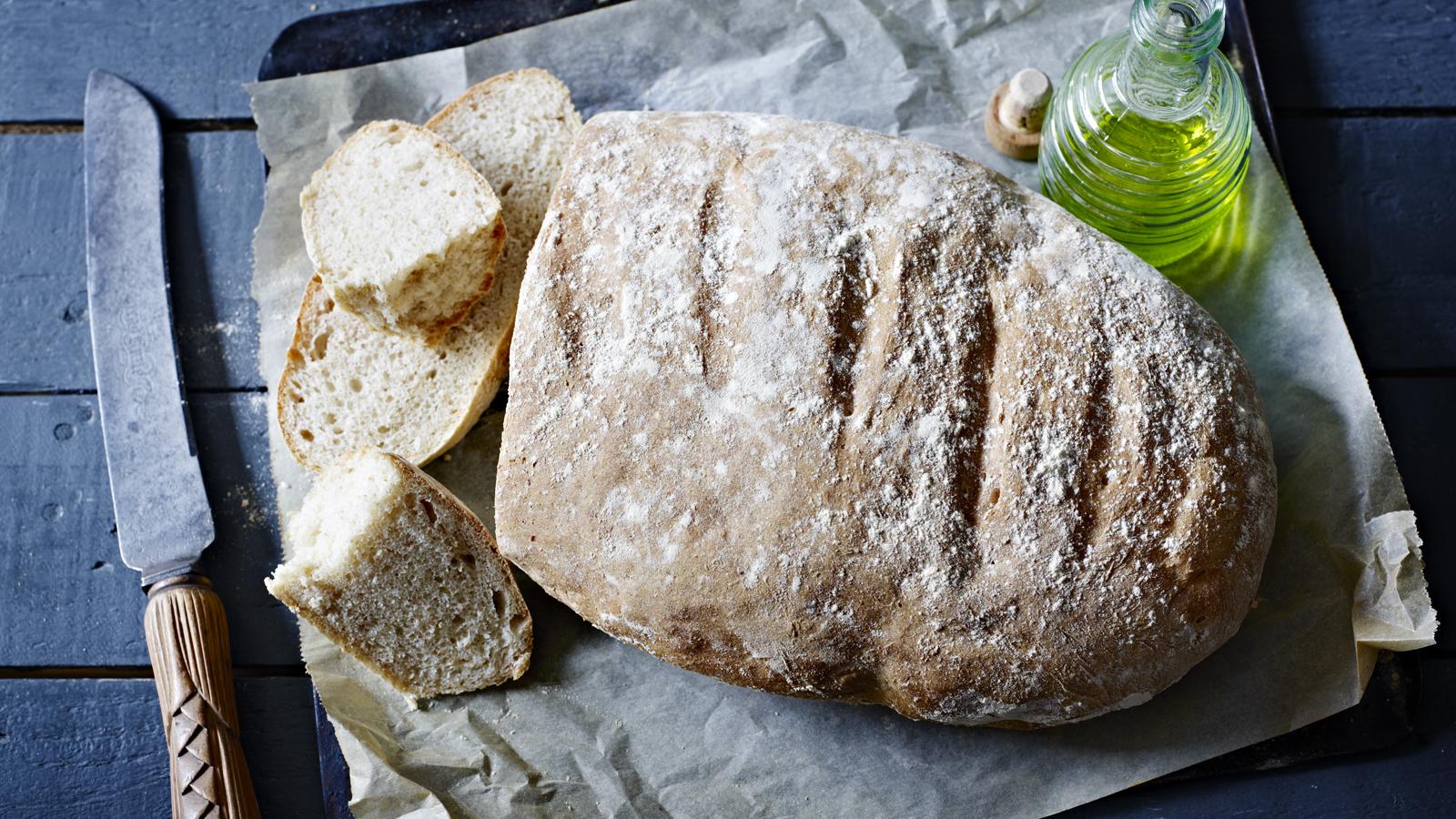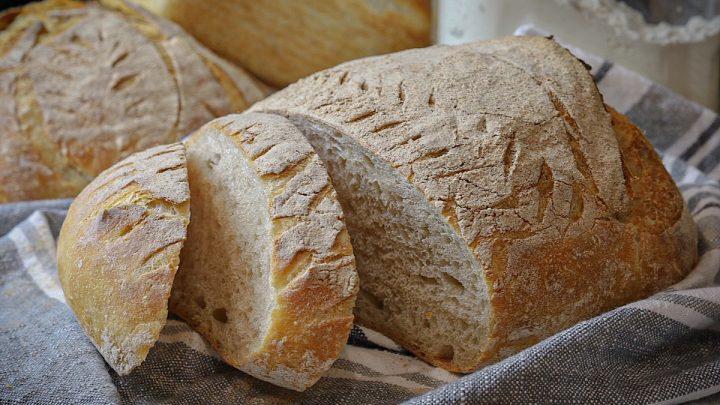Step into my kitchen, where I’ll reveal the secrets to creating the perfect Spanish White Bread. This recipe has been passed down through generations, capturing the essence of Spanish baking traditions. With a few simple ingredients and a little bit of patience, you’ll be rewarded with a loaf of bread that will impress your family and friends. Let’s get started!


Spanish White Bread
Equipment
- 1 large mixing bowl
- 1 greased bowl
- 1 greased pans
Ingredients
- 2 packets yeast
- 3 cups warm water
- 8–9 cups all-purpose flour
- 1⁄4 cup sugar
- 1 teaspoon salt
- 1⁄4 cup butter, melted
Instructions
- In a large mixing bowl, combine the yeast and sugar, and pour in the warm water. Cover, and let it stand for 5 minutes.
- Add the salt and 6 cups of the flour. Mix well.
- Add the melted butter and combine, and then add 2 more cups of flour. Mix well, and add more flour if necessary. The dough should be moist and soft, and not too stiff.
- Flour a clean working space, and knead the dough for 10 minutes, until it is smooth and elastic. Place it in a greased bowl, cover, and let it rise until its size doubles.
- Knead the dough briefly, and divide it into two loaves. Place it in greased pans, and let it rise again.
- Preheat the oven to 350°F, and bake the loaves for 35–45 minutes. Let them cook before serving.
Video
Notes
Cooking Tips

To ensure the best results when making Spanish White Bread, it’s important to pay attention to certain tips and tricks. By following these insights and avoiding common mistakes, you’ll be well on your way to achieving a delicious loaf of bread that will impress even the most discerning palates. Let’s dive into the cooking tips that will elevate your baking game.
- Flour Power: When measuring flour, use a kitchen scale for accuracy. The weight of flour can vary depending on how it’s packed, and using the right amount is crucial for a successful dough. Invest in a reliable kitchen scale and follow the recipe’s weight measurements for consistent results.
- Yeast Activation: Make sure your yeast is fresh and active before incorporating it into the dough. To activate the yeast, dissolve it in warm water (around 105°F/40°C) along with a pinch of sugar. Let it sit for 5-10 minutes until it becomes frothy. If the mixture doesn’t bubble, your yeast may be inactive, and it’s best to start with a fresh batch.
- Patience is Key: Allow the dough to rise in a warm, draft-free environment. This encourages yeast activity and helps the dough develop its light and airy texture. Be patient during the rising process and avoid rushing it, as this can result in a dense loaf. Follow the recipe’s recommended rise times for best results.
- The Perfect Bake: Preheat your oven properly and use a baking stone or a preheated baking sheet to ensure an evenly baked loaf. A hot baking surface promotes a crispy crust and a well-cooked interior. Additionally, misting the oven walls with water or placing a tray of hot water in the oven creates steam, enhancing the crust’s texture.
- Cooling and Storage: After baking, transfer the bread to a wire rack and allow it to cool completely before slicing. This ensures that the bread finishes cooking inside and avoids a gummy texture. Once cooled, store the bread in a paper bag or a bread box to maintain its freshness. Avoid storing it in plastic, as it can make the crust soft and damp.
Serving Suggestions

When it comes to Spanish White Bread, the possibilities are endless. From breakfast to dinner and everything in between, this versatile bread can be enjoyed in various ways. Let’s explore some serving suggestions that will take your culinary creations to new heights. Whether you’re hosting a brunch, preparing a sandwich for lunch, or seeking a delightful accompaniment to your dinner, this section will provide you with inspiration and guidance.
- Brunch Extravaganza: Start your day with a spread of toasted Spanish White Bread slices, accompanied by an array of toppings. Offer a selection of jams, spreads, and cheeses for a delightful breakfast experience. Don’t forget to brew a pot of aromatic coffee or prepare a refreshing pitcher of freshly squeezed juice to complete the meal.
- Savory Sandwiches: This Bread is perfect for creating mouthwatering sandwiches. Fill it with thinly sliced cured meats like Serrano ham or chorizo, along with a variety of cheeses and fresh vegetables. The bread’s soft interior and mild flavor will complement the savory fillings beautifully. Serve with a side of pickles or olives for an extra kick.
- Tapas Time: Spanish White Bread shines in traditional tapas-style dishes. Toast or grill slices of the bread and top them with flavorful ingredients like roasted red peppers, marinated artichokes, or Spanish-style tomato sauce. These bite-sized delights are perfect for entertaining guests or enjoying a light snack.
- Soup’s Best Friend: Pair a steaming bowl of Spanish gazpacho or creamy tomato soup with a side of toasted Spanish White Bread. The bread’s texture and mild flavor will absorb the soup’s delicious flavors, creating a comforting and satisfying combination. Serve with a sprinkle of fresh herbs for an added touch of elegance.
- Bread Pudding Bliss: Don’t let any leftovers go to waste! Transform stale White Bread into a delectable bread pudding. Soak the bread in a mixture of eggs, milk, sugar, and spices, then bake until golden and custardy. Serve warm with a drizzle of caramel or a scoop of vanilla ice cream for a delightful dessert.
FAQs about Spanish White Bread
As you embark on your Spanish White Bread journey, it’s natural to have questions along the way. Don’t worry—I’ve got you covered! Here are the answers to some frequently asked questions, ensuring that you have all the information you need to achieve baking success. And if you have additional queries, feel free to leave them in the comments below!
Can I freeze Spanish White Bread?
Absolutely! Spanish White Bread freezes well. Once the bread has cooled completely, wrap it tightly in plastic wrap, followed by a layer of aluminum foil. Freeze for up to three months. When ready to enjoy,simply thaw the bread at room temperature or gently warm it in the oven.
How long does Spanish White Bread stay fresh?
Freshly baked Spanish White Bread is best enjoyed within the first two days. To prolong its freshness, store it in a paper bag or a bread box at room temperature. Avoid storing it in the refrigerator, as it can accelerate staling. If the bread starts to stale, you can refresh it by toasting or warming it in the oven for a few minutes.
Can I make this Bread gluten-free?
While traditional Spanish White Bread is made with wheat flour, you can experiment with gluten-free flour blends to create a gluten-free version. Look for a gluten-free bread flour blend that is suitable for yeast-based recipes. Keep in mind that the texture and flavor may differ slightly from the original, but it’s a great option for those with gluten sensitivities or dietary restrictions.
Why did my bread turn out dense?
A few factors can contribute to a dense loaf of Spanish White Bread. One common mistake is using too much flour, resulting in a dry and heavy dough. Another factor may be insufficient rising time, which affects the bread’s texture. Ensure you follow the recipe’s instructions for measuring ingredients accurately and allowing the dough to rise until it doubles in size. Additionally, make sure your yeast is fresh and active for optimal rising.
Can I use this Bread for breadcrumbs?
Absolutely! Stale Spanish White Bread makes excellent breadcrumbs. Simply let the bread dry out completely, then pulse it in a food processor until you achieve the desired crumb texture. Store the breadcrumbs in an airtight container for future use. They are perfect for coating meats, adding crunch to casseroles, or topping baked dishes.
Take your baking skills to the next level with Spanish White Bread. Our expert tips will guide you through the process, helping you achieve a light and airy loaf every time. Explore the versatile ways to serve this bread, from brunch spreads to tapas delights and delightful sandwiches. Find answers to commonly asked questions and make sure to seize the opportunity to share the recipe and subscribe to our blog. Prepare to impress your family and friends with your newfound bread-making prowess.
